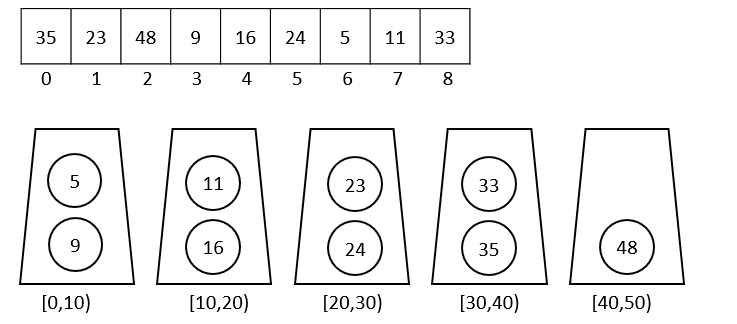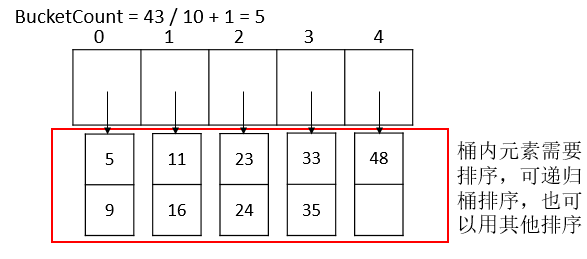排序 9桶排序
500 Words|Read in about 3 Min|本文总阅读量次
经典的排序算法,桶排序,用到了桶的概念
0准备
1//建立一个排序用的顺序表结构L
2#define MAXSIZE 9
3typedef struct SqList
4{
5 int r[MAXSIZE];
6 int length;
7}SqList;
8/*排序的交换函数*/
9void swap(SqList* L,int i,int j)
10{
11 int temp = L->r[i];
12 L->r[i] = L->r[j];
13 L->r[j] = temp;
14}
桶排序(BucketSort)
桶排序是计数排序的升级版。
桶排序(Bucket sort)的工作的原理
假设输入数据服从均匀分布,将数据分到有限数量的桶里,每个桶再分别排序(有可能再使用别的排序算法或是以递归方式继续使用桶排序)。
C的版本
1#define BUCKET_CAP (10)
2void BucketSort(SqList *L)
3{
4 if(L == nullptr || L->length < 2)
5 {
6 return;
7 }
8
9 int max = L->r[0], min = L->r[0];
10 //找到最大值最小值
11 for(int i = 0; i < L->length; i++)
12 {
13 if(L->r[i] > max)
14 {
15 max = L->r[i];
16 }
17 if(L->r[i] < min)
18 {
19 min = L->r[i];
20 }
21 }
22 int bucketCount = (max - min) / BUCKET_CAP + 1;
23 vector<int> buckets[bucketCount];//二维数组,长度为BUCKET_CAP大小的个数为桶的个数
24 // 入桶
25 for (int i = 0; i < L->length; i++) {
26 int idx = (L->r[i] - min) / BUCKET_CAP; //放入对应的桶
27 buckets[idx].push_back(L->r[i]);
28 if(buckets[idx].size() >= 2)
29 {
30 // 对该桶使用插入排序(因为数据过少,插入排序即可),维持该桶的有序性
31 for (int j = buckets[idx].size() - 1; j > 0; j--) {
32 if (buckets[idx][j] < buckets[idx][j-1]) {
33 swap(buckets[idx][j], buckets[idx][j-1]);
34 }
35 }
36 }
37 }
38 // 顺序访问桶,得到有序数组
39 for (int i = 0, k = 0; i < bucketCount; i++) {
40 for (int j = 0; j < int(buckets[i].size()); j++) {
41 L->r[k++] = buckets[i][j];
42 }
43 }
44}
Java版本
1//桶的容量,即每个桶所能放置多少个不同数值
2//bucketCap这里是2
3public static ArrayList<Integer> BucketSort(ArrayList<Integer> array, int bucketCap)
4{
5 if(array == null || array.size() < 2)
6 {
7 return array;
8 }
9
10 int max = array.get(0), min = array.get(0);
11 //找到最大值最小值
12 for(int i = 0; i < array.size(); i++)
13 {
14 if(array.get(i) > max)
15 {
16 max = array.get(i);
17 }
18 if(array.get(i) < min)
19 {
20 min = array.get(i);
21 }
22 }
23 //获得桶的数量
24 int bucketCount = (max - min) / bucketCap + 1;
25 //构建桶
26 ArrayList<ArrayList<Interger>> bucketArr = new ArrayList<>(bucketCount);
27 ArrayList<Interger> resultArr = new ArrayList<>();
28 for(int i = 0; i < bucketCount; i++)
29 {
30 bucketArr.add(new ArrayList<Integer>());
31 }
32 //将原始数组中的数据分配到桶中
33 for(int i = 0; i < array.size(); i++)
34 {
35 bucketArr.get((array.get(i) - min) / bucketCap).add(array.get(i));
36 }
37 //看桶中数据的分布
38 for(int i = 0; i < bucketArr.size(); i++)
39 {
40 System.out.println("第" + i + "个桶包含数据");
41 PrintArray.printObject(bucketArr.get(i));
42 }
43 //桶内数据在做相关的排序
44 for(int i = 0; i < bucketCount; i++)
45 {
46 if(1 == bucketCap)
47 {
48 for(int j = 0; j < bucketArr.get(i).size(); j++)
49 {
50 resultArr.add(bucketArr.get(i).get(j));
51 }
52 }else
53 {
54 if(1 == bucketCount)
55 {
56 bucketCap--;
57 }
58 System.out.println("对第" + i + "桶中的数据再次用桶进行排序");
59 ArrayList<Integer> temp = BucketSort(bucketArr.get(i), bucketCap);
60 for(int j = 0; j < temp.size(); j++)
61 {
62 resultArr.add(temp.get(j));
63 }
64 }
65 }
66 return reslutArr;
67}
桶的个数,BucketCount = 43 / 10 + 1 = 5
在桶排序中保证元素均匀分布到各个桶尤为关键。
举个反例,有数组[0,9,4,5,8,7,6,3,2,1]要排序,它们都是10以下的数,如果还按照上面的范围[0,10)建立桶,全部的元素将进入同一个桶中,此时桶排序就失去了意义。
实际情况我们很可能事先就不知道输入数据是什么,为了保证元素均匀分不到各个桶中,需要建立多少个桶,每个桶的范围是多少呢?
其实我们可以这样:简单点,首先限定桶的容量,再根据元素的个数来决定桶的个数。当然使用更复杂的方法也是可以的。 桶排序利用函数的映射关系,减少了几乎所有的比较工作。
实际上,桶排序的(K)值的计算,其作用就相当于快排中划分,已经把大量数据分割成了基本有序的数据块(桶)。然后只需要对桶中的少量数据做先进的比较排序即可。



